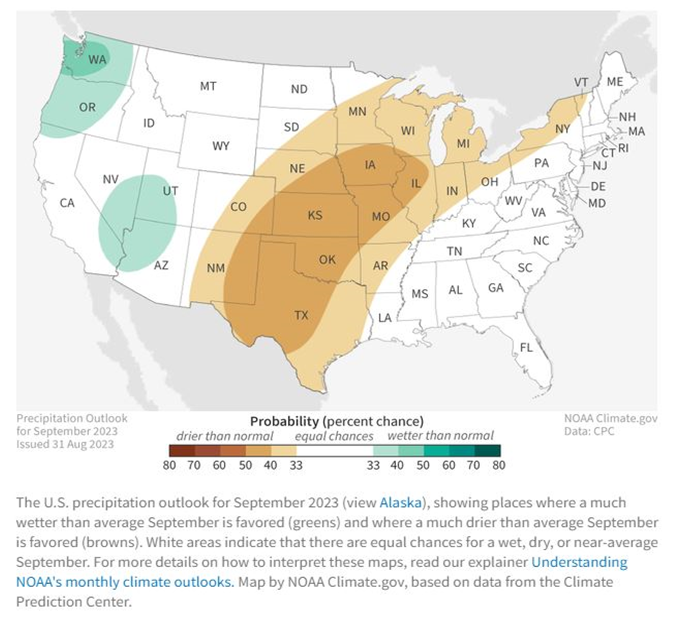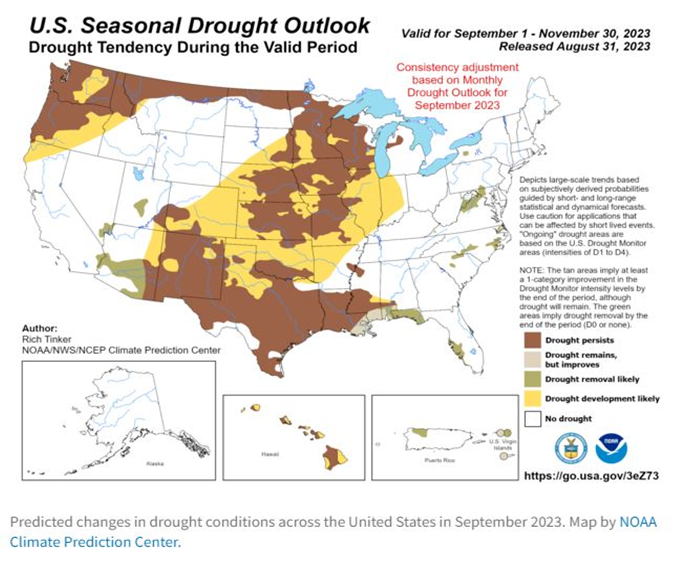An ideal spring turned dry quickly this year. Nearly all producers across the state of Missouri saw themselves in D3 drought conditions at one point during the summer. While we did see a wet August, it appears that the dry conditions from summer are going to linger into fall.
According to NOAA Climate Prediction Center’s weather outlook, summer conditions are here to stay a little longer. September is predicted to still be below average precipitation and above average temperatures. The drought outlook for fall isn’t favorable as we expect drought conditions to maintain. It is currently predicted for El Nino to strengthen and persist throughout winter, meaning warmer and drier conditions are expected. It sounds nice to have a mild winter forecasted, but it doesn’t help put us ahead in terms of drought conditions.
Since drought conditions are possible for the foreseeable future, what can we do now to get through? How do we prepare our operations after already having a summer that left us short on forages?
Many producers have already taken various steps to adapt to drought conditions. Actions such as culling cows, weaning early, chopping silage, buying hay, and practicing more intensive grazing are a few examples. These are all viable options, but as the fear of a lingering drought continues we must begin to think outside the box. This can range from looking at various feed supplements, reducing hay waste, and being proactive in pasture recovery management.
Below is an expert from Drought Management and Recovery Tips for Forages by the University of Arkansas, Division of Agriculture regarding pasture management for during and after drought conditions.
During Drought
Use rotational or controlled access grazing to extend grazing on any remaining forage. In drought-stressed pastures, treat any remaining forage as if it were standing hay and allocate it in strips or paddocks large enough for no more than 2-3 days grazing. Temporary electric fence is a good investment and is a great tool for strip grazing pasture. Properly installed electric fence systems with modern low impedance energizers will not start pasture fires. Some areas have received rain and forages are recovering. In green, growing pastures, rotational grazing will improve recovery due to more rest time for each paddock and will protect standing forage in case drought returns to those areas.
Avoid continued overgrazing. Drought-stressed pastures will recover more quickly if not overgrazed. Top growth mirrors root growth, so continued overgrazing causes weak, short roots that will further slow recovery. Overgrazing causes higher soil temperatures, because it removes residue that shades the soil surface.
Watch for insect pests such as armyworms, bermudagrass stem maggot, sugar cane aphid, and grasshoppers. Armyworm infestation is highly likely on the first fields to green up after rainfall since the moths key in on green tender growth for egg laying. Insecticide is a cost but protecting good quality green forage is cheaper than buying hay.
Protect purchased hay from weathering during storage. Hay can be stacked outside, but make sure it is up off the ground and covered. Stack it on pallets, poles, large crushed rock, or even tires. Cover it with a good quality hay tarp. The cheap blue tarps are not UV protected and will fall apart when exposed to wind and direct sunshine.
Hay barns make good commodity feed sheds. As hay is fed, consider alternative uses of empty barn space for storage of other feeds.
Protect hay when feeding to reduce waste. Feed hay in rings to reduce hay waste. Unrolling hay increases hay waste unless it is done on a limit-feeding basis. Hay can also be unrolled and protected by placing a single strand electric fence wire down the length of the line of hay. Cattle will line up as though they were at a feed bunk.
Crop residues can be harvested and sold for hay. Test crop residues for nitrate level and for feed value. Corn and milo stalks can have a high incidence of dangerous levels of. Feed value of all crop residues should be assumed to be low. Lab tests will help when developing a feeding strategy using crop residues. Also check the history of crop chemicals used on the crop during the growing season. Many chemicals prohibit use of treated crops for livestock feed.
During Recovery
Scout pastures closely for weeds. Some weeds such as wooly croton are avoided by livestock and populations can build unnoticed. Weeds can take over a weakened pasture quickly when rainfall occurs. Use concentrated grazing pressure or herbicide as appropriate to control specific weed species.
Fertilization will speed pasture recovery. When a good forecast of rain is predicted, apply some nitrogen fertilizer to the best pastures before the rain occurs. Phosphorus is important for root growth and can help plants with short root systems recover.
During and after recovery, graze the best pastures last. This practice will help ensure the best pastures continue to be the best pastures. Grazing too soon before adequate recovery will cause stand thinning, weed encroachment, and decline of pasture condition.
Drought-damaged pastures should be treated like newly seeded fields when recovery begins. When rainfall occurs and pastures begin to green up, defer grazing to allow top growth and roots to regrow. Grazing stressed pastures immediately after green up will further weaken plants and will lead to more pasture thinning especially over winter.
Plan to add annual forages in fall to provide fall and winter grazing. Seed supplies will not be unlimited this fall so find a seed source and reserve the amount needed early. Wheat prices are increasing and prices for rye, oats, and triticale could be high as well. The ryegrass seed crop is reportedly good in Oregon, but prices might be higher due to demand. Forage brassicas such as forage turnips can provide quick forage if planted correctly.
Evaluate pastures and determine which ones will recover, which ones need overseeding, and which ones needed complete renovation. In many cases, particularly with fescue and clover, seed produced earlier will germinate in fall and can fill in thin fields if grazing pressure is limited. In some cases, this will be a good opportunity to overseed clover into thin fields to boost forage quality and reduce N fertilizer requirements. Soil tests are needed to make sure soil pH and other fertility levels are adequate for clover. Cool-season forages such as fescue, orchard grass, and clover are best planted in fall. Warm-season grasses will need time to recover and likely will need well-planned weed control in late winter or early spring. Warm-season grasses should planted in mid-spring.
Droughts cause losses to our operations and there is no one size fits all solution. Whether it means purchasing extra forages or having to downsize our herd, many of the options come as a hit to the pocketbook. Pasture, Rangeland, and Forage (PRF) is a risk management tool that can be utilized to help minimize these losses. PRF insures against the lack of rainfall for roughly $5 an acre. This program can be completely customized to fit the needs of your operation. By selecting the coverage for the months you need the rainfall, you can minimize your risk. Producers who had PRF in place for 2023 were able to help offset the expenses that come along with navigating through a drought.
Sign up for 2024 PRF coverage is due by December 1. If you are interested in seeing how PRF can benefit your operation give our office a call today.


